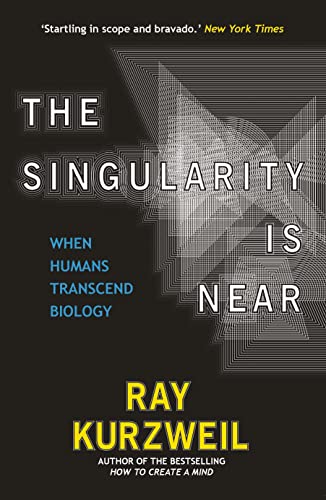Articles liés à The Singularity Is Near: When Humans Transcend Biology

Synopsis
For over three decades, Ray Kurzweil has been one of the most respected and provocative advocates of the role of technology in our future. In his classic The Age of Spiritual Machines, he argued that computers would soon rival the full range of human intelligence at its best. Now he examines the next step in this inexorable evolutionary process: the union of human and machine, in which the knowledge and skills embedded in our brains will be combined with the vastly greater capacity, speed, and knowledge-sharing ability of our creations.
Les informations fournies dans la section « Synopsis » peuvent faire référence à une autre édition de ce titre.
À propos de l?auteur
Ray Kurzweil is a prize-winning author and scientist. Recipient of the MIT-Lemelson Prize (the world’s largest for innovation), and inducted into the Inventor’s Hall of Fame, he received the 1999 National Medal of Technology. His books include The Age of SpiritualMachines and The Age of Intelligent Machines.
Visit Ray Kurzweil on the web:
http://www.kurzweiltech.com
http://www.kurzweilai.net/
Les informations fournies dans la section « A propos du livre » peuvent faire référence à une autre édition de ce titre.
- ÉditeurViking
- Date d'édition2005
- ISBN 10 0715635611
- ISBN 13 9780715635612
- ReliureBroché
- Langueanglais
- Nombre de pages672
- Coordonnées du fabricantnon disponible
EUR 4,15 expédition depuis Royaume-Uni vers France
Destinations, frais et délaisAcheter neuf
Afficher cet articleEUR 38,78 expédition depuis Etats-Unis vers France
Destinations, frais et délaisRésultats de recherche pour The Singularity Is Near: When Humans Transcend Biology
The Singularity Is Near : When Humans Transcend Biology
Vendeur : Better World Books Ltd, Dunfermline, Royaume-Uni
Etat : Very Good. Ships from the UK. Former library book; may include library markings. Used book that is in excellent condition. May show signs of wear or have minor defects. N° de réf. du vendeur 8126198-6
Quantité disponible : 1 disponible(s)
The Singularity is Near: When Humans Transcend Biology
Vendeur : WorldofBooks, Goring-By-Sea, WS, Royaume-Uni
Paperback. Etat : Good. In his now-classic and hugely influential exploration of the evolving union of human and machine, world-renowned inventor and futurist Ray Kurzweil foresees the dawning of a new civilisation where humans will transcend our biological limitations and amplify our creativity by combining our aptitudes with the vastly greater capacity, speed and knowledge-sharing abilities of Artificial Intelligence. This melding of human and machine is what he terms 'the singularity'. On the eve of publication of his latest book,The Singularity is Nearer, this new edition of the first instalment of his groundbreaking vision offers a fascinating and thought-provoking perspective on decades of innovation - and what still lies ahead. The book has been read but remains in clean condition. All pages are intact and the cover is intact. Some minor wear to the spine. N° de réf. du vendeur GOR002796325
Quantité disponible : 1 disponible(s)
The Singularity Is Near: When Humans Transcend Biology
Vendeur : LeLivreVert, Eysines, France
Etat : very good. Photo non contractuelle. Envoi rapide et soigné. N° de réf. du vendeur 9780715635612_2452_ZB198
Quantité disponible : 1 disponible(s)
The Singularity Is Near : When Humans Transcend Biology
Vendeur : Better World Books, Mishawaka, IN, Etats-Unis
Etat : Good. Used book that is in clean, average condition without any missing pages. N° de réf. du vendeur 14262608-6
Quantité disponible : 1 disponible(s)
The Singularity Is Near. When Humans Transcend Biology
Vendeur : Black Cat Bookshop P.B.F.A, Leicester, Royaume-Uni
Soft cover. Etat : As New. No Jacket. reprint. Large softback. Over 650 pages. N° de réf. du vendeur 006856
Quantité disponible : 1 disponible(s)
The Singularity Is Near: When Humans Transcend Biology
Vendeur : Studibuch, Stuttgart, Allemagne
paperback. Etat : Gut. 672 Seiten; 9780715635612.3 Gewicht in Gramm: 2. N° de réf. du vendeur 829074
Quantité disponible : 1 disponible(s)
The Singularity is Near: When Humans Transcend Biology
Vendeur : Goulds Book Arcade, Sydney, Newtown, Sydney, NSW, Australie
Paperback. Etat : Very Good. 652 pages. The cover is a little worn. The page edges are lightly tanned. Books listed here are not stored at the shop. Please contact us if you want to pick up a book from Newtown. N° de réf. du vendeur 158465
Quantité disponible : 1 disponible(s)
The Singularity is Near
Vendeur : BennettBooksLtd, North Las Vegas, NV, Etats-Unis
paperback. Etat : New. In shrink wrap. Looks like an interesting title! N° de réf. du vendeur Q-0715635611
Quantité disponible : 1 disponible(s)

